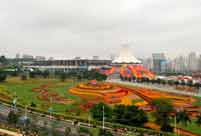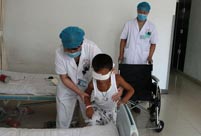An unmanned U.S. spacecraft rocketed toward the moon on Friday night on a mission to explore its atmosphere and the role of dust in the lunar sky.
The U.S. space agency NASA launched the Lunar Atmosphere and Dust Environment Explorer (LADEE) aboard a Minotaur V rocket at 11:27 p.m. Friday (0327 GMT Saturday) from its Wallops Flight Facility in eastern Virginia.
"There she goes. Lift off!!!" said Orbital Sciences Corp., owner of the Minotaur V rocket, via its official Twitter account. "Nominal flight so far."
Unlike the zippy three-day trip that Apollo astronauts took four decades ago, it will take about 30 days for the small car-sized spacecraft to reach the moon.
The 280-million-U.S.-dollar mission will gather detailed information about the structure and composition of the thin lunar atmosphere and study how moon dust behaves above the lunar surface, according to NASA.
Some Apollo astronauts reported seeing a strange glow on the moon's horizon before sunrise during NASA's lunar landing missions in the 1960s and 1970s. Scientists think this may have been caused by electrically charged moon dust, a theory that the LADEE is expected to test.
"Sometimes we get a little bit surprised when we start talking about a lunar atmosphere, because most of us were taught in school that the moon doesn't actually have an atmosphere," astronomy website Space.com quoted Sarah Noble, NASA's LADEE program scientist, as saying. "It does, but it's very, very thin."
The Lithium battery-powered spacecraft is about 7.7 feet (2.37 meters) high, 4.74 feet (1.85 meters) wide and 4.74 feet (1.85 meters) deep, about the size of a small car, with a mass of 547.2 pounds (248.2 kilograms), or 844.4 pounds (383 kilograms) when fully fueled.
Once it reaches the moon, the LADEE will begin its 40-day commissioning phase, the first 30 days of which the spacecraft will be performing activities high above the moon's surface.
These activities include testing a high-data-rate laser communication system that will enable higher rates of satellite communications similar in capability to high-speed fiber optic networks on Earth.
Next, the LADEE is expected to spend about 100 days studying the lunar environment before running out of fuel and crashing into the moon's surface.
There are no plans to target the impact points on the lunar surface, and if the spacecraft's fuel is depleted and orbital decay occurs naturally, the point of impact may not be in sight of Earth, NASA said.
 Mountain of garbage in Nairobi
Mountain of garbage in Nairobi Highlights of MAKS 2013 Int'l Aviation and Space Show
Highlights of MAKS 2013 Int'l Aviation and Space Show  10th China-ASEAN Expo opens in Nanning
10th China-ASEAN Expo opens in Nanning Eagle Boy takes to sky to break another record
Eagle Boy takes to sky to break another record 12-year-old boy becomes pillar of the family
12-year-old boy becomes pillar of the family Eye-gouged boy receives blind rehabilitation in Shanxi
Eye-gouged boy receives blind rehabilitation in Shanxi Top 10 naked hotels in the world
Top 10 naked hotels in the world The most gorgeous Chinese women in the eyes of foreigners
The most gorgeous Chinese women in the eyes of foreigners A collection of bizarre rooftop buildings around China
A collection of bizarre rooftop buildings around China Putin intimate contacts with marine animals
Putin intimate contacts with marine animals China's frigate 'Bengbu'in fire training
China's frigate 'Bengbu'in fire training Fresh students 'forced' to register in university independently
Fresh students 'forced' to register in university independently 2013 Taiwan Int'l Tourism Expo kicks off in Taipei
2013 Taiwan Int'l Tourism Expo kicks off in Taipei Photo story: Take a gap year
Photo story: Take a gap year Nokia's Global Headquarters: visiting a declining empire
Nokia's Global Headquarters: visiting a declining empireDay|Week|Month